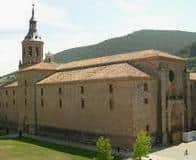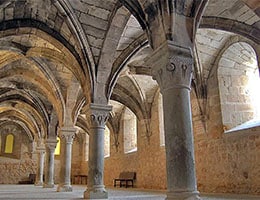 The Greek word monastḗrion came to late Latin as monasterĭum , which led to monastery in our language . This is the name given to the group of buildings where the monks live together as a community .
The Greek word monastḗrion came to late Latin as monasterĭum , which led to monastery in our language . This is the name given to the group of buildings where the monks live together as a community .
Monasteries are buildings that, long ago, were located on the outskirts of towns. In its origins the term referred to the home of a single monk, since the first Christian religious of this type were hermits .
As the years passed, the monks began to gather together and share their lives and faith as a community . This is how monasteries and convents arose.
Those who live in the monastery must respect the rules imposed by the religious order to which they belong. Usually the rules include chastity and the abandonment of personal possessions .
Within this framework are the so-called monastic rules , those that monastic orders , conventual or mendicant orders, among others, must respect, that is, they cover both the life of monks in monasteries and that of friars in convents. Although they present differences in various aspects, such as the degree of closure (the prohibition of leaving the building), they usually apply to regular clergy and consecrated life.
One of the best-known sets of rules in this area is found in the so-called Rule of Saint Augustine , written by him in the 4th century with the aim of organizing life within the monastery of Tagaste, which he had founded in the north of the continent. African. It is worth mentioning that the term is in the singular because when it comes to the religious sphere it acquires the meaning of " regulation ."
The Rule of Saint Augustine was written at three different times and includes norms for canonical hours, moral issues within the monastery, and the obligations of its members. It was adopted by various monasteries in Africa, beyond that of Tagaste, and a few centuries later it spread to clerical orders such as the Servites, the Mercedarians, the Dominicans, the Augustinians and the Premonstratensians .
Another important rule for life in the monastery is that of Saint Basil , which also dates from the 4th century and is attributed to Basil the Great . It is a guide that even today the Catholic Church uses to govern life in various orders and congregations, which are known as Basilians . These precepts were collected a century later and only in 800 did the monk and abbot Saint Theodore of Studion give them their final form.
 The Carthusian Customs , on the other hand, is a rule written for the Carthusian monks, a religious order founded by Saint Bruno in the 11th century. They were prepared by Guigo I , one of his successors, in the year 1127 and consist of 80 chapters. Among the rules expressed in its many pages are the maximum number of monks allowed per monastery, the characteristics of the facilities and the times at which they could meet.
The Carthusian Customs , on the other hand, is a rule written for the Carthusian monks, a religious order founded by Saint Bruno in the 11th century. They were prepared by Guigo I , one of his successors, in the year 1127 and consist of 80 chapters. Among the rules expressed in its many pages are the maximum number of monks allowed per monastery, the characteristics of the facilities and the times at which they could meet.
Although monasteries are associated with Christianity , there are also Buddhist monasteries , Hindu monasteries and other faiths. Beyond their differences, in all these homes those who wish to consecrate their lives to God or to the spiritual congregate.
In the case of Christian monasteries, the church is the most important building of the monastery. They also have other environments and areas such as the cloister, the library, the dining room and the bedrooms.
One of the best-known monasteries is the Monastery of El Escorial , which is part of the World Heritage Site protected by UNESCO . It was built in the 16th century in San Lorenzo de El Escorial ( Spain ) and includes, in addition to the monastery itself, a royal palace, a school and a pantheon, among other spaces.
